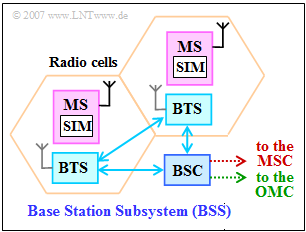Difference between revisions of "Aufgaben:Exercise 3.5Z: GSM Network Components"
| Line 71: | Line 71: | ||
{{ML-Kopf}} | {{ML-Kopf}} | ||
| − | '''(1)''' | + | '''(1)''' Each mobile station (MS) is in communication with a base transceiver station (BTS). This is part of the ''Base Station Subsystem'' (BSS) ⇒ <u>solution 1</u>. |
| − | '''(2)''' | + | '''(2)''' Correct are the <u>statements 1 and 3</u>. In contrast, the base transceiver station is not responsible for switching tasks, but this is rather the task of a mobile switching center (MSC), which is part of the switching and management subsystem (SMSS). |
| + | '''(3)''' If, as is usually the case with GSM, the individual antennas cover $120^\circ$ sectors, a BTS can provide up to three connection paths ⇒ $N_{\rm max} \hspace{0.15cm}\underline{= 3}$. | ||
| + | |||
| − | |||
| + | '''(4)''' Only the Operation and Management Center (OMC) belongs to the OMSS ⇒ <u> Proposal 3</u> . | ||
| + | *In contrast, MSC and GMSC are components of the mobile switching network (SMSS). | ||
| + | *With regard to OMC, a distinction is made between OMC-B (for BSS monitoring) and OMC-S (for SMSS monitoring). | ||
| − | + | '''(5)''' <u>solutions 1, 3 und 4</u> are correct: | |
| − | + | *The ''Gateway Mobile Switching Center'' (GMSC) is a hardware unit that is responsible for switching between the fixed network and the mobile network. | |
| − | + | *The other three terms given actually describe databases of the ''Switching & Management Subsystem'' (SMSS). | |
| − | + | * The ''Authentication Center'' (AUC) is responsible for the storage of confidential data and keys. | |
| − | + | * The Home Location Register (HLR) is a central register for the entire Public Land Mobile Network (PLMN) for managing unencrypted subscriber data, subscribed services and routing for calls from a mobile operator's own subscribers. | |
| − | '''(5)''' <u> | + | *Contrary, the Visitors' Location Register (VLR) contains information about the current visitors of other operators who are located in the current PLMN. |
| − | * | ||
| − | * | ||
| − | * | ||
| − | * | ||
| − | * | ||
Revision as of 16:03, 2 July 2020
For the mobile phone standard Global System for Mobile Communications - abbreviated GSM - the network infrastructure includes the following subsystems:
- Base Station Subsystem (BSS),
- Switching & Management Subsystem (SMSS),
- Operation & Maintenance Subsystem (OMSS).
The Base Station Subsystem is mainly responsible for the GSM radio network (see diagram), while the Switching & Management Subsystem represents the switching network and the Operation & Maintenance Subsystem is responsible for operation and maintenance.
The following terms will continue to be used in the questions on these tasks:
- Authentication Center (AUC)
- Base Station Controller (BSC),
- Base Transceiver Station (BTS),
- Gateway Mobile Switching Center (GMSC),
- Home Location Register (HLR),
- Mobile Switching Center (MSC),
- Operation and Maintenance Center (OMC),
- Visitor Location Register (VLR).
Notes:
- This task belongs to the chapter Charakteristika von GSM.
Fragebogen
Sample Solution
(1) Each mobile station (MS) is in communication with a base transceiver station (BTS). This is part of the Base Station Subsystem (BSS) ⇒ solution 1.
(2) Correct are the statements 1 and 3. In contrast, the base transceiver station is not responsible for switching tasks, but this is rather the task of a mobile switching center (MSC), which is part of the switching and management subsystem (SMSS).
(3) If, as is usually the case with GSM, the individual antennas cover $120^\circ$ sectors, a BTS can provide up to three connection paths ⇒ $N_{\rm max} \hspace{0.15cm}\underline{= 3}$.
(4) Only the Operation and Management Center (OMC) belongs to the OMSS ⇒ Proposal 3 .
- In contrast, MSC and GMSC are components of the mobile switching network (SMSS).
- With regard to OMC, a distinction is made between OMC-B (for BSS monitoring) and OMC-S (for SMSS monitoring).
(5) solutions 1, 3 und 4 are correct:
- The Gateway Mobile Switching Center (GMSC) is a hardware unit that is responsible for switching between the fixed network and the mobile network.
- The other three terms given actually describe databases of the Switching & Management Subsystem (SMSS).
- The Authentication Center (AUC) is responsible for the storage of confidential data and keys.
- The Home Location Register (HLR) is a central register for the entire Public Land Mobile Network (PLMN) for managing unencrypted subscriber data, subscribed services and routing for calls from a mobile operator's own subscribers.
- Contrary, the Visitors' Location Register (VLR) contains information about the current visitors of other operators who are located in the current PLMN.
